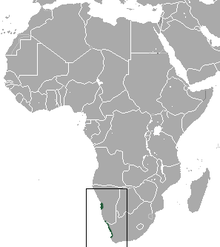Grant's golden mole
| Grant's golden mole | |
|---|---|
 | |
| Namib golden mole (Eremitalpa granti ssp. namibensis) | |
| Scientific classification | |
| Domain: | Eukaryota |
| Kingdom: | Animalia |
| Phylum: | Chordata |
| Class: | Mammalia |
| Order: | Afrosoricida |
| Family: | Chrysochloridae |
| Genus: | Eremitalpa Roberts, 1924 |
| Species: | E. granti |
| Binomial name | |
| Eremitalpa granti (Broom, 1907) | |
| Subspecies | |
| E. g. granti | |
 | |
| Grant's golden mole range | |
Grant's golden mole (Eremitalpa granti; colloquially also: dune shark) is a golden mole species. It is the only member of the genus Eremitalpa.
Description
[edit]Like all other golden moles, the build of these animals is similar to the moles, though they are not closely related, and are adapted to a life of digging. The front extremities are remodelled to digging claws; in contrast to most other species of its family, they have three claws each. The tail is physically not visible, there are no auricles, the eyes are covered with fur, and the mouth is bearing a leather-like pad, which also serves for digging.
Grant's golden moles have long silky fur, which is coloured grey on cubs and sandy on older animals. With a length of 7.5 to 9 cm (3.0 to 3.5 in) and a weight of 15 to 25 g (0.53 to 0.88 oz) it is the smallest member of family Chrysocholoridae.[2]
Geographical distribution and habitat
[edit]Grant's golden mole lives on the western coast of South Africa and in south western Namibia.[1] Its natural habitat is dry areas, mostly sandy deserts.[1]
Diet and social behaviour
[edit]
In contrast to many other golden moles, Grant's golden mole rarely builds lasting tunnels. It "swims" through the sand just under or on the surface while searching for food. It is mainly a nocturnal animal, resting by day in small caves beneath sheltering plants.[1] It is a solitary animal, with stomping grounds averaging 4.6 ha. When foraging at night, the animal will alternate between moving over the surface sand, dipping its head into the substrate (detecting low frequency vibrations through the ground)[3] and "swimming" through the sand.[3]
Besides termites (which constitute the majority of its food) and other invertebrates, its diet consists of reptiles such as skinks.
Taxonomy
[edit]There are two subspecies:[4]
- West Coast dune golden mole (Eremitalpa granti ssp. granti)
- Namib golden mole (Eremitalpa granti ssp. namibensis)
Conservation status
[edit]This species has been classified by the IUCN Red List as LC (Least Concern) globally.[1] However, the Endangered Wildlife Trust of South Africa regards the nominate subspecies as a Vulnerable species.[5]
References
[edit]- ^ a b c d e Maree, S. (2015). "Eremitalpa granti". IUCN Red List of Threatened Species. 2015: e.T7994A21283661. doi:10.2305/IUCN.UK.2015-2.RLTS.T7994A21283661.en. Retrieved 18 November 2021.
- ^ Roth, Jason. "Eremitalpa granti (Grant's golden mole)". Animal Diversity Web. Retrieved 2025-03-06.
- ^ a b Narins, Peter M.; Lewis, Edwin R.; Jarvis, Jennifer J.U.M.; O’Riain, Justin (1997). "The Use of Seismic Signals by Fossorial Southern African Mammals: A Neuroethological Gold Mine". Brain Research Bulletin. 44 (5): 641–646. doi:10.1016/S0361-9230(97)00286-4. PMID 9365810. S2CID 22657527.
- ^ "Grant's Golden Mole (Eremitalpa granti)". iNaturalist. Retrieved 2025-01-08.
- ^ "Endangered Wildlife Trust - Red Data". ewt.org.za. Retrieved 22 January 2025.
Further reading
[edit]- Ronald M. Nowak: Walker's Mammals of the World. The Johns Hopkins University Press, Baltimore 1999, ISBN 0-8018-5789-9.
- Bronner, G.N.; Jenkins, P.D. (2005). "Order Afrosoricida". In Wilson, D.E.; Reeder, D.M (eds.). Mammal Species of the World: A Taxonomic and Geographic Reference (3rd ed.). Johns Hopkins University Press. pp. 71–81. ISBN 978-0-8018-8221-0. OCLC 62265494.
- Rundell, Katherine (2022). Consider the Golden Mole. Faber & Faber. ISBN 978-0571362493.


 French
French Deutsch
Deutsch